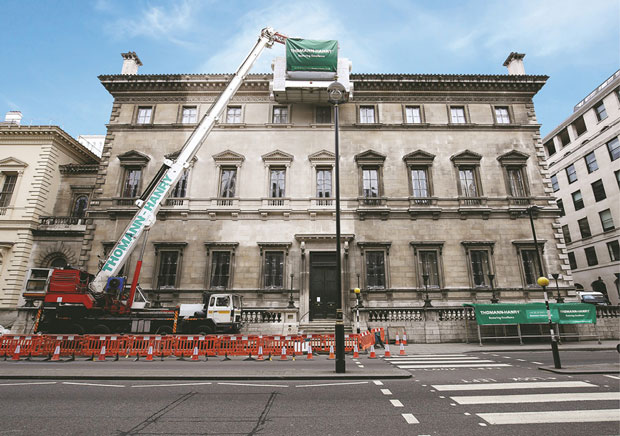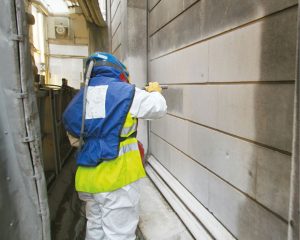DRY CLEANING METHODS
There are two key types of dry-cleaning methods, abrasive cleaning and façade gommage cleaning. With abrasive cleaning methods a medium to high pressure is used with an abrasive medium such as sand, shot, or ground-up nut shells to chip away at the surface of the dirt and grime. With this type of cleaning a good surface clean can be achieved but it can cause damage to the façade’s surface especially on softer stones such as sandstones and limestone, repeated use can, over time, cause highly decorative and intricate areas to be damaged or worn away by this method.
With the façade gommage cleaning method, ultra-fine aluminium silicate powder is blown under low pressure over the surface of the façade, gently rubbing away the surface dirt and grime. Unlike most wet and dry options, scaffolding isn’t required so reducing the time taken to perform the clean and no temporary structures obscuring the building (an ideal choice for hotels and retail businesses). The system also offers one of the best end results, taking a building back to the original façade colour while preserving any patina which may be present.
CHEMICAL & SPOT SURFACE CLEANING METHODS
When smaller more specific areas need cleaning, such as to remove graffiti or more stubborn or encrusted stains, the use of specific cleaning methods such as chemical treatments, are more commonly used. These need to be patch tested to ensure there is no reaction to any of the materials on the façade.
Poultice application can also be used, but once again only on small areas after patch testing has been carried out. These topical pastes are applied and left to remove stains, but with typical ‘dwell’ periods of 24 to 72 hours, these are slow and may require additional applications for them to be effective.
Lazer and cryogenic cleaning methods use ablation as a way of removing encrusted dirt and grime. Once again this is not suitable for larger areas of soiling.
It’s not just the method which needs to be considered when looking to clean and refresh a historic or listed building’s façade. The company you are looking to employ will also need to show that they understand the need for sympathetic cleaning for these types of building.
For those buildings which have listed or scheduled monument status, working with a company who understands the constrains which will need to be applied to any cleaning methods is vital. Ask to see examples of the types of buildings which they have previously worked on and how they were able to execute a sympathetic façade clean.






